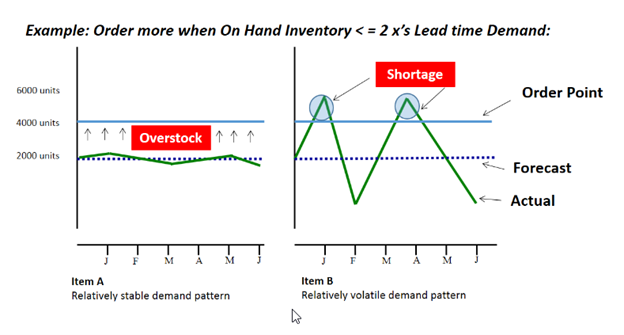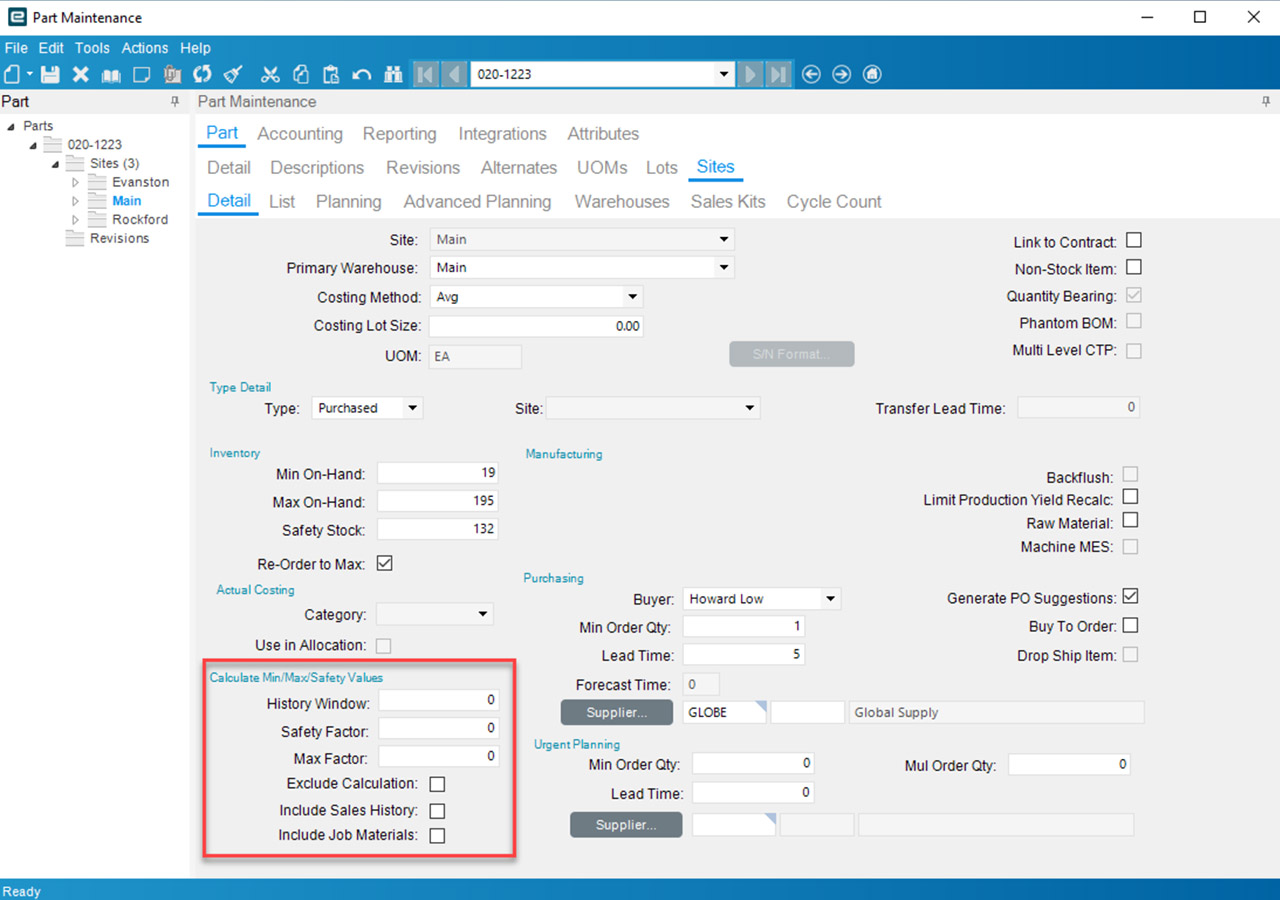Extend Epicor Kinetic’s Forecasting & Min/Max Planning with Smart IP&O
Epicor Kinetic can manage replenishment by suggesting what to order and when via reorder point-based inventory policies. Users can either manually specify these reorder points or use a daily average of demand to dynamically compute the policies. If the policies aren’t correct then the automatic order suggestions will be inaccurate, and in turn the organization will end up with excess inventory, unnecessary shortages, and a general mistrust of their software systems. In this article, we will review the inventory ordering functionality in Epicor Kinetic, explain its limitations, and summarize how Smart Inventory Planning & Optimization (Smart IP&O) can help reduce inventory, minimize stockouts and restore your organization’s trust in your ERP by providing the robust predictive functionality that is missing from ERP systems.
Epicor Kinetic (and Epicor ERP 10) Replenishment Policies
In the item maintenance screen of Epicor Kinetic, users can enter planning parameters for every stock item. These include Min On-Hand, Max On-Hand, Safety Stock lead times, and order modifiers such as supplier imposed minimum and maximum order quantities and order multiples. Kinetic will reconcile incoming supply, current on hand, outgoing demand, stocking policies, and demand forecasts (that must be imported) to net out the supply plan. Epicor’s time-phased replenishment inquiry details what is up for order and when while the Buyers Workbench enables users to assemble purchase orders.
Epicor’s Min/Max/Safety logic and forecasts that are entered into the “forecast entry” screen drives replenishment. Here is how it works:
- The reorder point is equal to Min + Safety. This means whenever on hand inventory drops below the reorder point an order suggestion will be created. If demand forecasts are imported via Epicor’s “forecast entry” screen the reorder point will account for the forecasted demand over the lead time and is equal to Min + Safety + Lead time forecast
- If “reorder to Max” is selected, Epicor will generate an order quantity up to the Max. If not selected, Epicor will order the “Min Order Qty” if MOQ is less than the forecasted quantity over the time fence. Otherwise, it will order the forecasted demand over the time-period specified. In the buyer’s workbench, the buyer can modify the actual order quantity if desired.
Limitations
Epicor’s Min/Max/Safety relies on an average of daily demand. It is easy to set up and understand. It can also be effective when you don’t have lots of demand history. However, you’ll have to create forecasts and adjust for seasonality, trend, and other patterns externally. Finally, multiples of averages also ignore the important role of demand or supply variability and this can result in misallocated stock as illustrated in the graphic below:

In this example, two equally important items have the same average demand (2,000 per month) and safety stock is determined by doubling the lead time demand resulting in a reorder point of 4,000. Because the multiple ignores the role of demand variability, Item A results in a significant overstock and Item B results in significant stockouts.
As designed, Min should hold expected demand over lead time and Safety should hold a buffer. However, these fields are often used very differently across items without a uniform policy; sometimes users even enter a Min and Safety Stock even though the item is being forecasted, effectively over estimating demand! This will generate order suggestions before it is needed, resulting in overstocks.
Spreadsheet Planning
Many companies turn to spreadsheets when they face challenges setting policies in their ERP system. These spreadsheets often rely on user defined rule of thumb methods that often do more harm than good. Once calculated, they must input the information back into Epicor, via manual file imports or even manual entry. The time consuming nature of the process leads companies to infrequently compute their inventory policies – Many months of even years go by in between mass updates leading to a “set it and forget it” reactive approach, where the only time a buyer/planner reviews inventory policy is at the time of order. When policies are reviewed after the order point is already breached it is too late. When the order point is deemed too high, manual interrogation is required to review history, calculate forecasts, assess buffer positions, and to recalibrate. The sheer volume of orders means that buyers will just release orders rather than take the painstaking time to review everything leading to significant excess stock. If the reorder point is too low, it’s already too late. An expedite is now required driving up costs and even then you’ll still lose sales if the customer goes elsewhere.
Epicor is Smarter
Epicor has partnered with Smart Software and offers Smart IP&O as a cross platform add-on to Epicor Kinetic and Prophet 21 with API based integrations. This enables Epicor customers to leverage built for purpose best of breed forecasting and inventory optimization applications. With Epicor Smart IP&O you can automatically recalibrate policies every planning cycle using field proven, cutting-edge statistical and probabilistic models. You can calculate demand forecasts that account for seasonality, trend, and cyclical patterns. Safety stocks will account for demand and supply variability, business conditions, and priorities. You can leverage service level driven planning so you have just enough stock or turn on optimization methods that prescribe the most profitable stocking policies and service levels that consider the real cost of carrying inventory. You can build consensus demand forecasts that blend business knowledge with statistics, better assess customer and sales forecasts, and confidently upload forecasts and stocking policies to Epicor within a few mouse-clicks.
Smart IP&O customers routinely realize 7 figure annual returns from reduced expedites, increased sales, and less excess stock, all the while gaining a competitive edge by differentiating themselves on improved customer service. To see a recorded webinar hosted by the Epicor Users Group that profiles Smart’s Demand Planning and Inventory Optimization platform, please register here: https://smartcorp.com/epicor-smart-inventory-planning-optimization/


